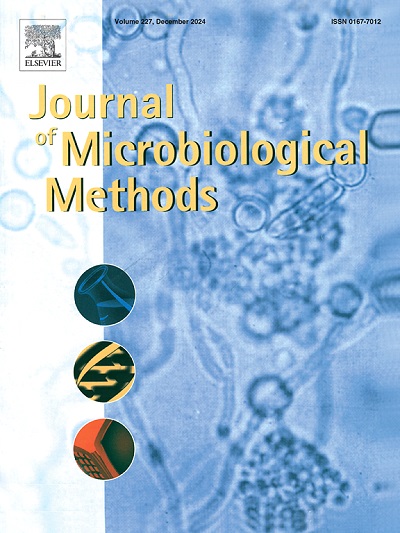以平菇卵为原料的微球在不同水质条件下生产漆酶的应用研究。
IF 1.9
4区 生物学
Q4 BIOCHEMICAL RESEARCH METHODS
引用次数: 0
摘要
近年来,氧化还原酶(如漆酶)因其在酶基废水处理过程中降解和消除受污染水中有机微污染物的能力而受到相当大的关注。因此,在水中产生高漆酶活性的方法是一个重点,白腐真菌被强调为在这种情况下的工具。因此,本研究探讨了白腐菌平菇(Pleurotus ostreatus)菌种在水中直接添加的应用途径及其在不同条件下产生漆酶的潜力。结果表明,颗粒菌种的漆酶活性为53.9±5.9 U/L,木屑菌种的漆酶活性为4.8±0.8 U/L。添加4 g/L硫酸盐木质素可诱导籽粒菌种漆酶活性提高8倍,达到446.3±43.1 U/L。随着时间的推移,木质素在菌种中积累,形成由菌种、菌丝和木质素组成的棕色小球。我们的研究结果表明,使用这种方法可以在不同类型的水中获得高水平的漆酶活性,包括城市污水。添加无机氮(硝酸铵,n水平为14 mg/L, 140 mg/L)或有机氮源(尿素,酵母浸膏,麦麸,n水平为14 mg/L, 140 mg/L)对籽粒卵和木质素处理没有影响,表明在这些营养条件下可以预期稳定的漆酶活性。本文章由计算机程序翻译,如有差异,请以英文原文为准。

Spawn-based pellets of Pleurotus ostreatus as an applied approach for the production of laccase in different types of water
In recent years, oxidoreductase enzymes such as laccases have received considerable attention for their ability to degrade and eliminate organic micropollutants from contaminated water in a process known as enzyme-based wastewater treatment. Thus, methods to produce high laccase activity in water are a point of focus, with white-rot fungi being highlighted as a tool in this context. This study, therefore, explored the applied approach of direct addition of mushroom spawn of the white-rot fungi Pleurotus ostreatus into water and its potential for laccase production under different conditions. Grain spawn was observed to be preferable to sawdust spawn, resulting in laccase activity of 53.9 ± 5.9 U/L and 4.8 ± 0.8 U/L, respectively. Laccase activity was induced by adding kraft lignin (4 g/L), and an eightfold increase to 446.3 ± 43.1 U/L was observed for grain spawn. Lignin accumulated in the spawn over time, resulting in brown pellets composed of spawn, mycelium and lignin. Our results demonstrated that high levels of laccase activity could be obtained in different types of water, including effluent municipal wastewater, using this method. No impact from the addition of inorganic nitrogen (ammonium nitrate, N-levels 14 mg/L, 140 mg/L) or organic nitrogen sources (urea, yeast extract, wheat bran, N-levels 14 mg/L, 140 mg/L) was observed for the treatment with grain spawn and lignin, suggesting that stable laccase activity can be expected under these nutritional conditions.
求助全文
通过发布文献求助,成功后即可免费获取论文全文。
去求助
来源期刊

Journal of microbiological methods
生物-生化研究方法
CiteScore
4.30
自引率
4.50%
发文量
151
审稿时长
29 days
期刊介绍:
The Journal of Microbiological Methods publishes scholarly and original articles, notes and review articles. These articles must include novel and/or state-of-the-art methods, or significant improvements to existing methods. Novel and innovative applications of current methods that are validated and useful will also be published. JMM strives for scholarship, innovation and excellence. This demands scientific rigour, the best available methods and technologies, correctly replicated experiments/tests, the inclusion of proper controls, calibrations, and the correct statistical analysis. The presentation of the data must support the interpretation of the method/approach.
All aspects of microbiology are covered, except virology. These include agricultural microbiology, applied and environmental microbiology, bioassays, bioinformatics, biotechnology, biochemical microbiology, clinical microbiology, diagnostics, food monitoring and quality control microbiology, microbial genetics and genomics, geomicrobiology, microbiome methods regardless of habitat, high through-put sequencing methods and analysis, microbial pathogenesis and host responses, metabolomics, metagenomics, metaproteomics, microbial ecology and diversity, microbial physiology, microbial ultra-structure, microscopic and imaging methods, molecular microbiology, mycology, novel mathematical microbiology and modelling, parasitology, plant-microbe interactions, protein markers/profiles, proteomics, pyrosequencing, public health microbiology, radioisotopes applied to microbiology, robotics applied to microbiological methods,rumen microbiology, microbiological methods for space missions and extreme environments, sampling methods and samplers, soil and sediment microbiology, transcriptomics, veterinary microbiology, sero-diagnostics and typing/identification.
 求助内容:
求助内容: 应助结果提醒方式:
应助结果提醒方式:


